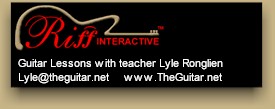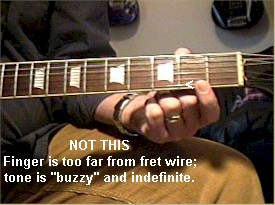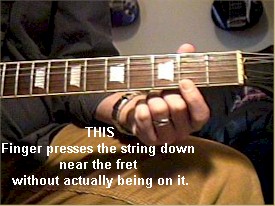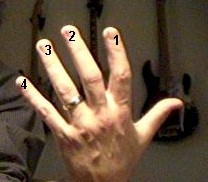Scroll through the lesson and click on notation/video/audio links to load the interactive players.
Please subscribe to get full access to all lessons for only $7.95/month PLUS 1 week free trial.

Riff Interactive lessons are
LESS expensive and
MORE interactive than alternatives!
More Info
|
|

Beginning Guitar I
- Lesson 2
Finger
Stretching – Reading TAB
Lyle: In the last lessons you've learned how to
tune your guitar, now you need to learn how to hold the guitar and the pick,
where to put your fingers, and how to read guitar tablature (TAB).
Lyle: Let's quickly go over how to hold
your guitar. If you're sitting down with the guitar, you shouldn't need a strap.
Simply balance the guitar on your leg. Your shoulders and knees should be
straight out, square ahead of you and the guitar neck pointing away from
you.
sitting with
the guitar
standing with
the guitar
Lyle:
The left-hand positioning is important. Put the tip of your thumb opposite the
joints of your second and third fingers. Keep your elbow in and your fingers
curved.
finger
placement 1

finger placement 2

finger placement 3

Lyle: When you place a left-hand finger on a
string, make sure you press firmly and close to the fret wire as you can without
actually being right on it. This will help you produce a clean, bright
tone.
four finger
stretch
four finger
stretch
Lyle:
Your left hand fingers are numbered as:
finger numbers

Lyle: Your right-hand has an easy job, holding
the pick, and strumming. Here's an demonstration on
video:
right hand
position
Lyle:
Any questions before we move on?
Francric: What if your fingers can't stretch all the
way?
Lyle: You should examine your wrist grip. You
should be able to reach all four frets with one finger on each fret. Relax and
"drop" your wrist down so that your fingers curl back up over the fretboard.
Examine the video demonstration called "four finger stretch". Get them close
enough so that you can produce a good sound when you pick each of the
notes.
Lyle: This is a very important issue for many
beginners, getting their fingers to stretch. If you have a good left-hand
position, it will be easier to reach the long stretches.
Lyle: A good exercise is the four finger stretch
on all strings. In later lessons I'll teach you a whole bunch of good finger
exercises for stretching, dexterity, and speed.
Lyle: Let's move on to the subject How To Read
TAB!
How To Read TAB
Lyle: TAB - TABLATURE
graphically represents the guitar fingerboard. Each horizontal line represents a
string, and each number represents a
fret.
Lyle: The bottom line is your low/big E string -
#6:
the open
strings
open
strings
Lyle:
Here's a couple different ways tab can
look:
basics
basics
Lyle:
Now I'll take you through many of the different notation
symbols.

Lyle: HALF-STEP BEND: Strike the
note and bend up 1/2 step.
half step bend
half step
bend

Lyle: WHOLE-STEP BEND: Strike
the note and bend up one step.
whole step bend
whole step
bend
Lyle: A
half-step = one fret, a whole-step = 2
frets.

Lyle: ONE AND A HALF-STEP BEND:
Strike the note and bend up 1 1/2 steps.
one and a half step bend
one and a half
step bend
Lyle:
Acoustic guitars have heavy gauge strings and are very hard to bend, don't worry
about it.
Francric: You are pushing with all three
fingers?
Lyle: Yes, when you bend a note, grab the string
with three fingers and you'll have more strength and control of the
bend.

Lyle: SLIGHT (MICROTONE) BEND:
Strike the note and bend up 1/4 step.
quarter step bend
quarter step
bend
Francric: How should your fingers
be so they don't touch the string above when pushing or coming
down?
Lyle: It's ok if your fingers push or
pull into the other strings. Try to mute any unwanted noise with either
hand.

Lyle: BEND AND RELEASE: Strike
the note and bend up as indicated, then release back to the original note. Only
the first note is struck.
bend and release
bend and
release

Lyle: PRE-BEND: Bend the note as
indicated, then strike it.
pre-bend
pre-bend
Francric:
What's the purpose of a pre bend?
Lyle: It's an effect that is very unique to
stringed instruments. You can do a pre-bend and then follow it with a release
bend for a "sneaky sound" or a bluesy
sound.
Francric:
So you wouldn't play it without a
release?
Lyle: You might play it several times in a row
before you release it. Lots of blues riffs use all the bending
techniques.

Lyle: VIBRATO: The string is
vibrated by rapidly bending and releasing the note with the fretting
hand.
vibrato
vibrato

Lyle: WIDE VIBRATO: The pitch is
varied to a greater degree by vibrating with the fretting
hand.
wide
vibrato
wide
vibrato

Lyle: HAMMER-ON: Strike the
first (lower) note with one finger, then sound the higher note (on the same
string) with another finger by fretting it without
picking.
hammer-on
hammer-on

Lyle: PULL-OFF: Place both
fingers on the notes to be sounded. Strike the first note and without picking,
pull the finger off to sound the second (lower) note.
pull-off
pull-off

Lyle: LEGATO SLIDE: Strike the
first note and then slide the same fret-hand finger up or down to the second
note. The second note is not struck.
legato slide
legato
slide

Lyle: SHIFT SLIDE: Same as
legato slide, except the second note is struck.
shift
slide
shift
slide

Lyle: TRILL: Very rapidly
alternate between the notes indicated by continuously hammering on and pulling
off.
trill
trill

Lyle: TAPPING: Hammer ("tap")
the fret indicated with the pick-hand index or middle finger and pull off to the
note fretted by the fret hand.
tapping
tapping

Lyle: NATURAL HARMONIC: Strike
the note while the fret-hand lightly touches the string directly over the fret
indicated.
natural
harmonic
natural
harmonic

Lyle: PINCH HARMONIC: The note
is fretted normally and a harmonic is produced by adding the edge of the thumb
or the tip of the index finger of the pick hand to the normal pick
attack.
pinch
harmonic
pinch
harmonic

Lyle: MUFFLED STRINGS: A
percussive sound is produced by laying the fret hand across the string(s)
without depressing, and striking them with the pick.
muffled
strings
Anessa: Are
a lot of these better suited for an electric guitar?
muffled
strings
Lyle:
Mostly the bending techniques, but any of these can be done and used on the
acoustic guitar.

Lyle: PALM MUTING: The note is
partially muted by the pick hand lightly touching the string(s) just before the
bridge.
palm
muting
palm
muting

Lyle: RAKE: Drag the pick across
the strings indicated with a single
motion.
rake
rake

Lyle: That is the majority of the different
tablature notations and techniques you'll end up using as you learn to play your
guitar!
Lyle: Let's take a break for now. Give your
fingers a rest or go roam around the Riff Interactive web archives and try
playing any of the TABs you find there, since you now are familiar with how to
read them! Email me at Lyle@theguitar.net if you have any
questions or you would like to get your own custom lesson made for you on almost
any guitar topic. I can even teach you how to play your favorite songs! Thanks,
Lyle
|
<< load notation from left
|
|
<< load audio from left
|
<< load audio from left
|